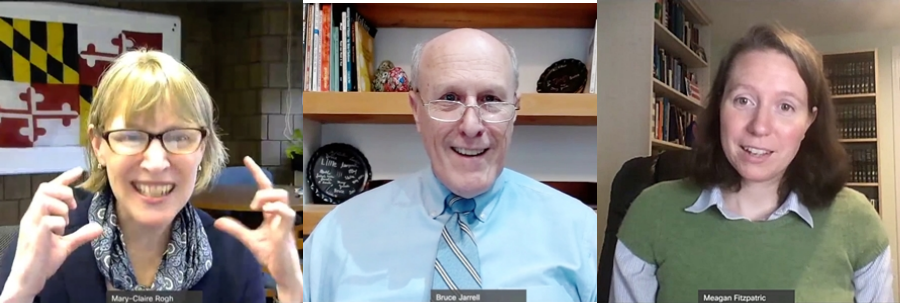As the mercury is dropping around the U.S., new cases of COVID-19 are rising — and rapidly — sparking questions about how to approach the holidays, which often involve travel and family gatherings.
“If things do not change, if they continue on the course they’re on, there’s gonna be a whole lot of pain in this country,” National Institute of Allergy and Infectious Diseases director Anthony Fauci, MD, told CNBC cable television host Shepard Smith during an Oct. 28 interview. “We are on a very difficult trajectory. We are going in the wrong direction.”

(l-r) Mary-Claire Roghmann, Bruce Jarrell, and Meagan Fitzpatrick
Fauci’s comments came five days after the U.S. marked the highest daily number of new COVID-19 cases during the pandemic — more than 82,000. At the same time, data showed more than 37 states were reporting higher numbers of new cases.
And those higher numbers aren’t just because of increased testing. The Johns Hopkins COVID Coronavirus Resource Center says that over the seven days ending last Sunday, testing increased about 5.5 percent, while the number of new COVID cases increased 25.5 percent.
With nothing to indicate that those numbers are headed back down anytime soon, Americans are starting to see the return of restrictions to travel, some businesses, and schools.
On Tuesday, children in Dorchester County on Maryland’s Eastern Shore were the first in the state to go back to 100 percent virtual learning, as that rural county’s test positivity rate surged past 6 percent. Across the country, the news is even worse.
“There seems to be a COVID storm on the rise, and we have to get prepared,” said Illinois Gov. J.B. Pritzker. All across that state there are new restrictions on businesses at the state and local levels.
The same thing is happening in Newark, N.J., where the mayor is calling it a desperate situation.
In El Paso, Texas, County Judge Ricardo Samaniego imposed a two-week stay-at-home order and a strict curfew, citing already-crowded hospital intensive care units.
And in Utah, a group of hospital administrators has told the governor they may have to start rationing health care in a week or two if ICUs there continue to be flooded with COVID-19 patients. They plan to use criteria like age, health conditions, and ability to survive to determine who should be allowed to stay in hospitals.
And the list goes on, particularly in the upper Midwest and Mountain States. In North Dakota, 5 percent of the entire population has already contracted the coronavirus and it’s only October.
Although scientists have long predicted increased COVID infections in the fall and winter, the questions remain about the probable causes — cold weather that pushes people indoors, lax adherence to prophylactic practices, confusion about best practices. Perhaps more significantly, questions are also rising about how to stay safe with holiday travel and in family gatherings.
The guests on the Oct. 29 edition of Virtual Face to Face with Dr. Bruce Jarrell came ready with answers and a broad range of expertise. Mary-Claire Roghmann, MD, MS, is a professor of epidemiology and public health, and medicine in the University of Maryland School of Medicine (UMSOM). She was joined by colleague UMSOM assistant professor Meagan Fitzpatrick, PhD, an infectious disease transmission modeler with the Center for Vaccine Development and Global Health.
Following a discussion with program host UMB President Bruce E. Jarrell, MD, FACS, the guests answered a wide array of questions from the audience of UMB students and employees, including how to stay safe at Thanksgiving gatherings, whether the guests themselves would get on a plane during the holidays, and whether trick-or-treating this weekend is a good idea for the kids.
To watch the discussion, use the link at the top of the story.


